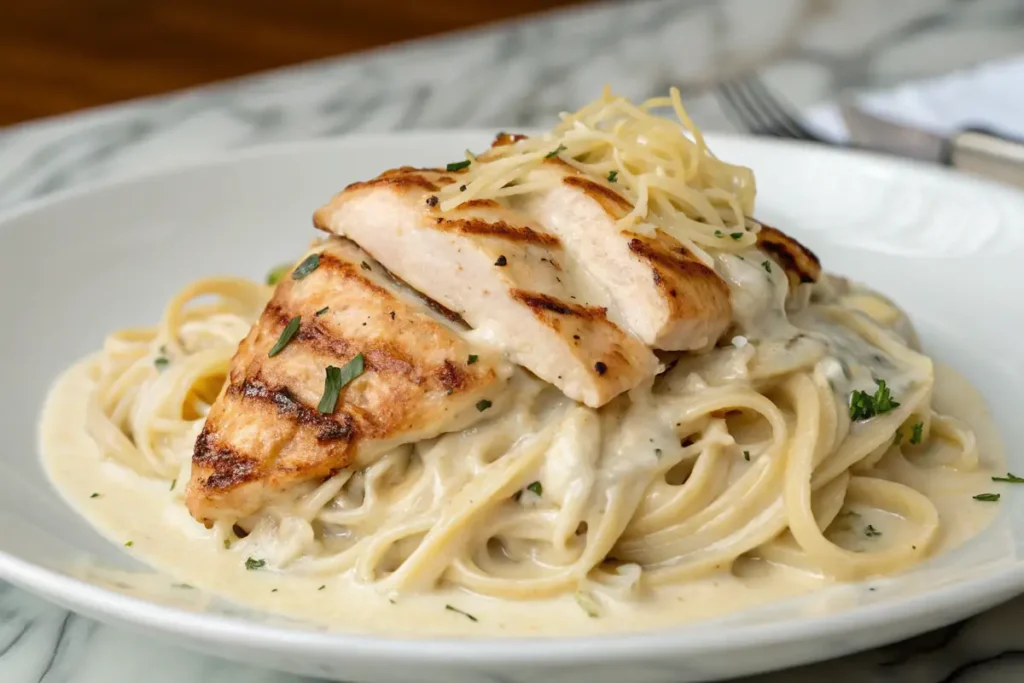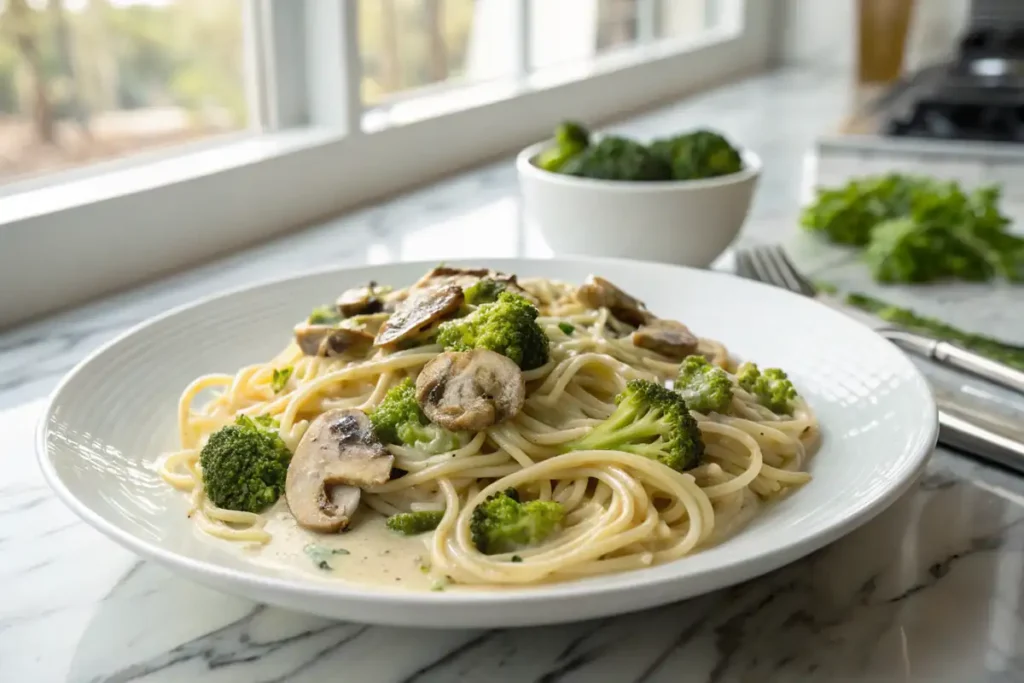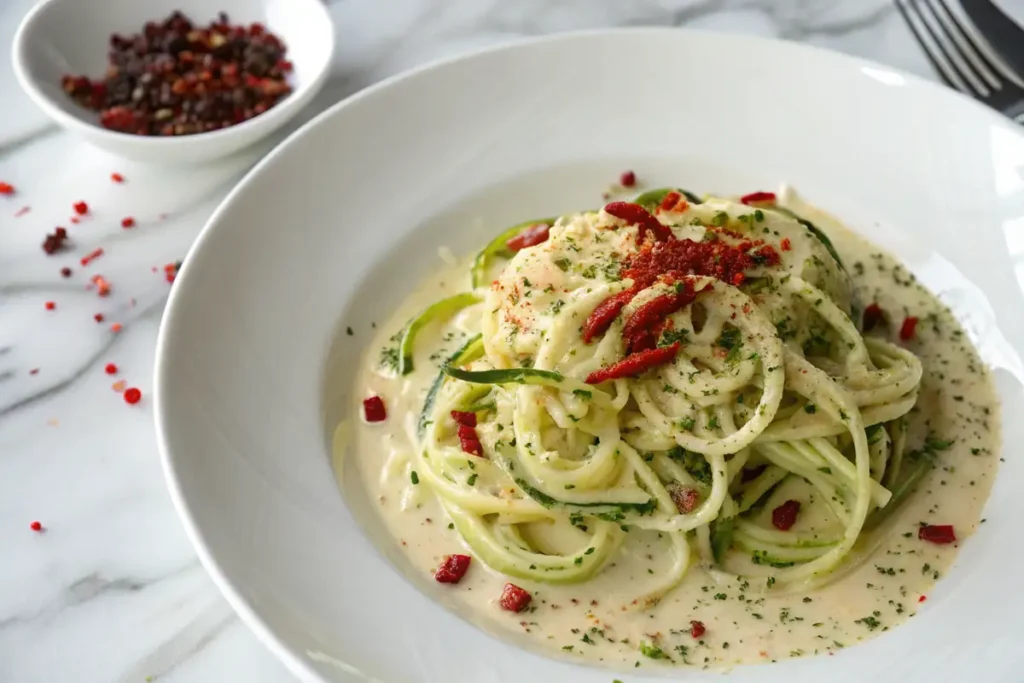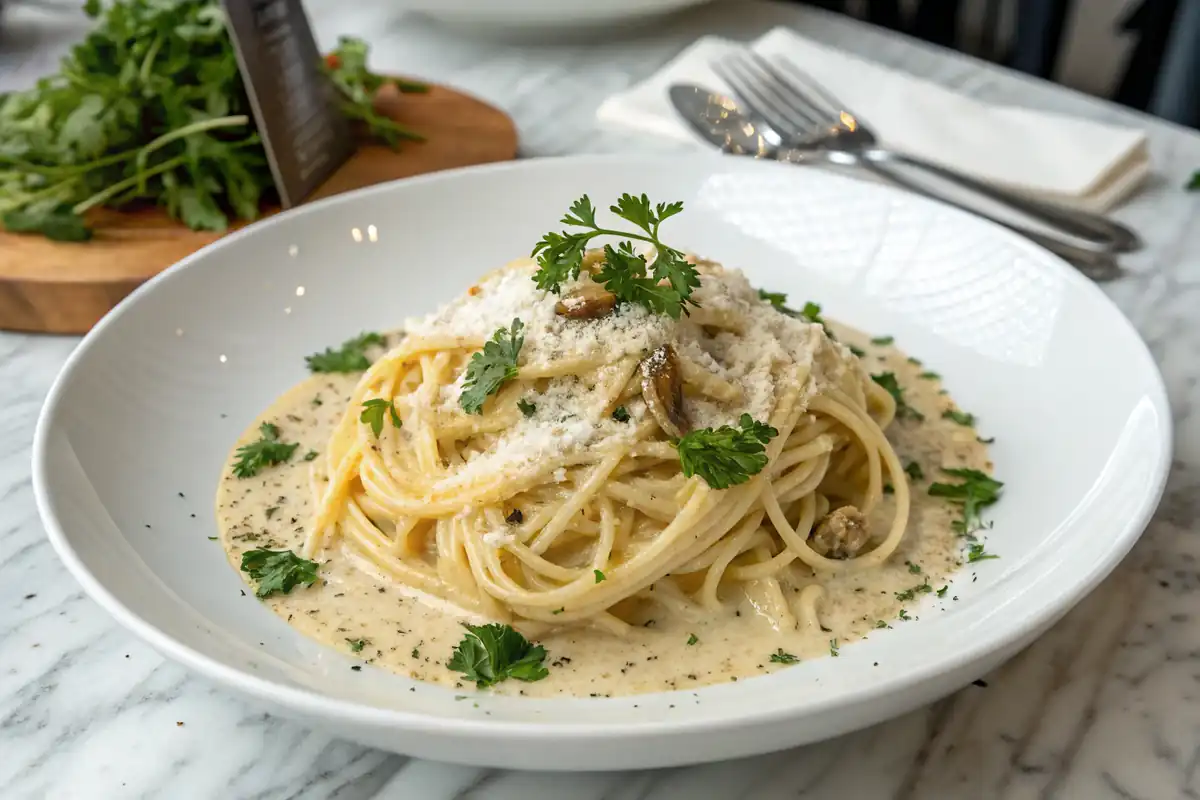If you’re a fan of creamy, comforting pasta dishes, Alfredo spaghetti is a must-try. This Italian-inspired classic has won hearts worldwide with its rich, velvety sauce and tender noodles. Whether you’re cooking for a family dinner or impressing guests, this dish is a crowd-pleaser. In this article, we’ll dive into everything you need to know about Alfredo spaghetti—from its history and ingredients to step-by-step cooking instructions and nutritional info. Plus, we’ll share tips, variations, and answers to your burning questions. Let’s get started!
Introduction to Alfredo Spaghetti
What is Alfredo Spaghetti?
Alfredo spaghetti is a delicious pasta dish made with spaghetti noodles coated in a creamy Alfredo sauce. The sauce, a blend of butter, heavy cream, and Parmesan cheese, is simple yet indulgent. While the dish is now a staple in American kitchens, its roots trace back to Italy.
The original Alfredo sauce was created by Alfredo di Lelio in Rome in the early 20th century. He made it to soothe his pregnant wife’s nausea, and it quickly became a hit. Over time, the dish crossed the Atlantic and evolved into the Alfredo spaghetti we know and love today.
Why Alfredo Spaghetti is a Family Favorite
There’s something magical about a plate of Alfredo spaghetti. It’s creamy, comforting, and incredibly versatile. Whether you’re a busy parent looking for a quick dinner or a foodie experimenting with flavors, this dish fits the bill.
One of the best things about Alfredo spaghetti is how easy it is to customize. You can keep it simple with just the sauce and noodles or jazz it up with add-ins like grilled chicken, shrimp, or veggies. It’s also a great way to get kids to eat their pasta—after all, who can resist that creamy goodness?
So, whether you’re a seasoned cook or a beginner, Alfredo spaghetti is a recipe worth mastering. Stick around as we explore the ingredients, cooking steps, and more!
Ingredients for the Perfect Alfredo Spaghetti
Essential Ingredients for Alfredo Sauce
To make the creamiest Alfredo spaghetti, you’ll need a handful of simple yet high-quality ingredients. First, grab some butter—it’s the base of the sauce and adds richness. Next, heavy cream gives the sauce its signature velvety texture. Don’t forget Parmesan cheese; its sharp, nutty flavor is what makes the sauce truly special.
Garlic is another must-have. It adds a subtle kick that balances the creaminess. Finally, season with salt and pepper to taste. If you’re feeling adventurous, a pinch of nutmeg can elevate the flavor even further.
Choosing the Right Spaghetti
While fettuccine is the traditional choice for Alfredo dishes, spaghetti works just as well. Its long, thin strands hold the sauce beautifully, ensuring every bite is packed with flavor. If you’re out of spaghetti, feel free to use linguine or tagliatelle—they’re equally delicious.
When cooking the noodles, aim for al dente—firm to the bite. Overcooked pasta can turn mushy and ruin the dish. Pro tip: Save a cup of the pasta water before draining. It’s a lifesaver if your sauce needs thinning later.
Optional Add-Ins for Extra Flavor
One of the best things about Alfredo spaghetti is how customizable it is. If you’re in the mood for something heartier, toss in some grilled chicken or shrimp. For a veggie-packed version, try adding broccoli, mushrooms, or spinach. These add-ins not only boost the flavor but also make the dish more nutritious.
If you’re looking for inspiration, check out our guide on how to make creamy pasta dishes for more ideas.
Step-by-Step Cooking Instructions
Preparing the Spaghetti
Start by boiling a large pot of salted water. Once it’s bubbling, add the spaghetti and cook according to the package instructions. Remember, al dente is the goal here—usually around 8-10 minutes.
While the pasta cooks, reserve about a cup of the starchy pasta water. This liquid gold will help bind the sauce to the noodles later. Once done, drain the spaghetti and set it aside.
Making the Alfredo Sauce from Scratch
Now, let’s whip up that creamy Alfredo sauce. In a large skillet, melt butter over medium heat. Add minced garlic and sauté until fragrant—about 30 seconds. Be careful not to burn it, as it can turn bitter.
Next, pour in the heavy cream and let it simmer gently. Stir in freshly grated Parmesan cheese until it melts into the sauce. Season with salt, pepper, and a pinch of nutmeg if desired. If the sauce feels too thick, add a splash of the reserved pasta water to loosen it up.
Combining Spaghetti and Alfredo Sauce
Once the sauce is smooth and creamy, add the cooked spaghetti to the skillet. Toss everything together until the noodles are evenly coated. If the dish seems dry, add more pasta water, a tablespoon at a time, until you reach the desired consistency.
Serving Suggestions
Transfer the Alfredo spaghetti to a serving dish and garnish with freshly chopped parsley or a sprinkle of extra Parmesan cheese. For a bit of heat, add a dash of red pepper flakes. Serve it with a side of garlic bread or a crisp green salad to round out the meal.
If you’re curious about pairing this dish with other sides, check out our article on perfect pasta pairings for more ideas.
Nutritional Information
Health Benefits of Alfredo Spaghetti
While Alfredo spaghetti is undeniably indulgent, it does offer some nutritional benefits. For starters, the dish is rich in calcium thanks to the Parmesan cheese and heavy cream. Calcium is essential for strong bones and teeth. Additionally, the pasta provides carbohydrates, which are a great source of energy.
However, moderation is key. The dish is high in calories and saturated fat, so it’s best enjoyed as an occasional treat rather than a daily staple. To make it healthier, consider using whole-grain spaghetti or adding more veggies like spinach or broccoli.
If you’re curious about the specific benefits of Parmesan cheese, check out this detailed guide on the Nutritional Benefits of Parmesan Cheese – Healthline.
Nutritional Content (Per 100g)
Here’s a breakdown of the nutritional content of Alfredo spaghetti per 100 grams:
| Nutrient | Amount (per 100g) |
|---|---|
| Calories | 310 kcal |
| Protein | 9 g |
| Carbohydrates | 31 g |
| Fat | 18 g |
| Saturated Fat | 10 g |
| Sodium | 230 mg |
This table gives you a clear idea of what you’re consuming. If you’re watching your calorie intake, consider portion control or opting for lighter versions of the dish.
Variations of Alfredo Spaghetti
Classic Alfredo Spaghetti
The classic Alfredo spaghetti is all about simplicity. It features just the creamy sauce and perfectly cooked noodles. This version is perfect for purists who want to enjoy the dish in its most authentic form.
Chicken Alfredo Spaghetti

For a protein-packed twist, try Chicken Alfredo Spaghetti. Simply add grilled or shredded chicken to the dish. The chicken not only adds flavor but also makes the meal more filling. It’s a great option for those looking to turn this dish into a complete meal.
Seafood Alfredo Spaghetti
If you’re a seafood lover, Seafood Alfredo Spaghetti is a must-try. Shrimp, scallops, or even crab meat can take this dish to the next level. The seafood pairs beautifully with the creamy sauce, creating a luxurious dining experience.
Vegetarian Alfredo Spaghetti

For a meatless version, Vegetarian Alfredo Spaghetti is the way to go. Add veggies like spinach, broccoli, or sun-dried tomatoes for extra flavor and nutrition. This variation is perfect for vegetarians or anyone looking to add more greens to their diet.
Low-Carb Alfredo Spaghetti

If you’re watching your carb intake, Low-Carb Alfredo Spaghetti is a fantastic alternative. Swap out the traditional noodles for zucchini noodles (zoodles) or spaghetti squash. These options are lower in carbs but still delicious and satisfying. For more information on the health benefits of zucchini noodles, check out this guide on Health Benefits of Zucchini Noodles – WebMD.
Tips for Storing and Reheating Alfredo Spaghetti
How to Store Leftovers
Let’s face it—Alfredo spaghetti is so good, you might end up with leftovers. Luckily, storing them is a breeze. First, let the dish cool to room temperature. Then, transfer it to an airtight container. Pop it in the fridge, and it’ll stay fresh for up to 3-4 days.
If you want to keep it longer, freezing is an option. Simply portion the Alfredo spaghetti into freezer-safe containers or bags. It can last in the freezer for up to 2 months. Just remember to thaw it in the fridge overnight before reheating.
Reheating Without Losing Creaminess
Reheating Alfredo spaghetti can be tricky, as the sauce tends to separate. To avoid this, use the stovetop method. Place the leftovers in a skillet over low heat. Add a splash of milk or cream to loosen the sauce, stirring gently until it’s warm and creamy again.
If you’re in a hurry, the microwave works too. Cover the dish with a damp paper towel to lock in moisture. Heat it in 30-second intervals, stirring in between, until it’s evenly warmed.
Avoiding Common Reheating Mistakes
One of the biggest mistakes is overheating the sauce, which can make it greasy or grainy. Always reheat on low heat and stir frequently. If the sauce does separate, don’t panic—just whisk in a bit of warm milk or cream to bring it back together.
FAQs About Alfredo Spaghetti
What is it called when you mix spaghetti sauce and Alfredo sauce?
When you mix spaghetti sauce (marinara) and Alfredo sauce, it’s often called Pink Sauce or Rosé Sauce. This blend combines the tangy flavor of tomato sauce with the creamy richness of Alfredo, creating a unique and delicious dish.
What is Alfredo spaghetti called?
Alfredo spaghetti is commonly known as Spaghetti Alfredo. However, if you use fettuccine noodles instead, it’s traditionally called Fettuccine Alfredo. Both versions are equally creamy and satisfying.
Are spaghetti noodles good for Alfredo?
Absolutely! While fettuccine is the classic choice, spaghetti noodles work just as well. Their long, thin strands hold the sauce beautifully, ensuring every bite is packed with flavor.
Does it taste good to mix Alfredo and marinara?
Yes, mixing Alfredo and marinara sauces creates a delightful combination. The creaminess of the Alfredo balances the tanginess of the marinara, resulting in a rich and flavorful sauce. It’s a great way to switch things up if you’re tired of the usual.
Conclusion and Final Thoughts
Why You Should Try This Recipe
If you haven’t already, it’s time to give Alfredo spaghetti a try. This dish is more than just a meal—it’s a comforting experience that brings people together. Whether you’re cooking for your family or hosting a dinner party, Alfredo spaghetti is sure to impress.
What makes this recipe so special is its versatility. You can keep it simple with just the sauce and noodles or get creative with add-ins like chicken, shrimp, or veggies. Plus, it’s easy to make, even for beginners.
Encouragement to Experiment
Don’t be afraid to put your own spin on Alfredo spaghetti. Try different cheeses, like Romano or Asiago, for a unique flavor. Or, swap out the spaghetti for another pasta shape, like penne or bowties. The possibilities are endless, so have fun with it!

